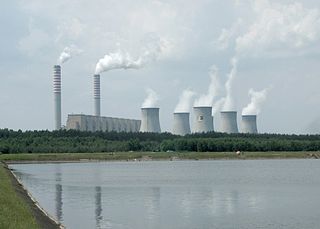Tuanku Jaafar Power Station is one of the main power stations in Malaysia, located in Port Dickson, Negeri Sembilan. The power station belongs to Tenaga Nasional Berhad and is a state-of-art combined cycle power plants comprise PD1 (750MW MHI Technology) and PD2 (750MW GE-TOSHIBA Technology).

Malaysia is a country in Southeast Asia. The federal constitutional monarchy consists of 13 states and three federal territories, separated by the South China Sea into two similarly sized regions, Peninsular Malaysia and East Malaysia. Peninsular Malaysia shares a land and maritime border with Thailand in the north and maritime borders with Singapore in the south, Vietnam in the northeast, and Indonesia in the west. East Malaysia shares land and maritime borders with Brunei and Indonesia and a maritime border with the Philippines and Vietnam. Kuala Lumpur is the national capital and largest city while Putrajaya is the seat of federal government. With a population of over 30 million, Malaysia is the world's 44th most populous country. The southernmost point of continental Eurasia, Tanjung Piai, is in Malaysia. In the tropics, Malaysia is one of 17 megadiverse countries, with large numbers of endemic species.

Negeri Sembilan is a state in Malaysia which lies on the western coast of Peninsular Malaysia. It borders Selangor on the north, Pahang in the east, and Melaka and Johor to the south.
PD1 was on commercial loading in 2005 whereas PD2 started in February 2009. Both combined cycle plants are firing natural gas supplied by Petronas with distillate as a stand-by fuel.
The first phase of Tuanku Jaafar Power Station began in 1969, when it was a conventional thermal power plant (firing fuel-oil) 4 x 60MW units. This was followed in 1978 with 3 x 120MW units. A 25MW Gas Turbine was added for blackstart and peaking purposes.
In 2000, the conventional power plant was dismantled in stages to allow for rehabilitation project, which was fully completed in 2009. Tuanku Jaafar Power Station has now become the power plant of choice (top in the merit order) with high efficiency, full automation (Automatic Governor Control-AGC), in compliance to the international standards and environment.

Fluidized bed combustion (FBC) is a combustion technology used to burn solid fuels.

In electric power generation a combined cycle power plant is an assembly of heat engines that work in tandem from the same source of heat, converting it into mechanical energy, which in turn usually drives electrical generators. The principle is that after completing its cycle, the temperature of the working fluid in the system is still high enough that a second subsequent heat engine extracts energy from the heat that the first engine produced. By combining these multiple streams of work upon a single mechanical shaft turning an electric generator, the overall net efficiency of the system may be increased by 50–60%. That is, from an overall efficiency of say 34%, to possibly an overall efficiency of 62%, 84% Theoretical efficiency

Cogeneration or combined heat and power (CHP) is the use of a heat engine or power station to generate electricity and useful heat at the same time. Trigeneration or combined cooling, heat and power (CCHP) refers to the simultaneous generation of electricity and useful heating and cooling from the combustion of a fuel or a solar heat collector. The terms cogeneration and trigeneration can be also applied to the power systems generating simultaneously electricity, heat, and industrial chemicals – e.g., syngas or pure hydrogen.
Puget Sound Energy (PSE) is a Washington state energy utility providing electrical power and natural gas primarily in the Puget Sound region of the northwest United States. The utility serves electricity to more than 1.1 million customers in Island, King, Kitsap, Kittitas, Pierce, Skagit, Thurston, and Whatcom counties; and provides natural gas to 750,000 customers in King, Kittitas, Lewis, Pierce, Snohomish and Thurston counties. The company has a 6,000-square-mile (16,000 km2) electric and natural gas service area.

A fossil fuel power station is a thermal power station which burns a fossil fuel such as coal, natural gas, or petroleum to produce electricity. Central station fossil fuel power plants are designed on a large scale for continuous operation. In many countries, such plants provide most of the electrical energy used. Fossil fuel power stations have machinery to convert the heat energy of combustion into mechanical energy, which then operates an electrical generator. The prime mover may be a steam turbine, a gas turbine or, in small plants, a reciprocating internal combustion engine. All plants use the energy extracted from expanding gas, either steam or combustion gases.
Although different energy conversion methods exist, all thermal power station conversion methods have efficiency limited by the Carnot efficiency and therefore produce waste heat.

The Senoko Power Station is the largest power station in Singapore. It is located in Senoko, Sembawang and was commissioned in 1976. It is owned by Senoko Energy Pte Ltd, formerly known as Senoko Power Ltd.
An integrated gasification combined cycle (IGCC) is a technology that uses a high pressure gasifier to turn coal and other carbon based fuels into pressurized gas—synthesis gas (syngas). It can then remove impurities from the syngas prior to the power generation cycle. Some of these pollutants, such as sulfur, can be turned into re-usable byproducts through the Claus process. This results in lower emissions of sulfur dioxide, particulates, mercury, and in some cases carbon dioxide. With additional process equipment, a water-gas shift reaction can increase gasification efficiency and reduce carbon monoxide emissions by converting it to carbon dioxide. The resulting carbon dioxide from the shift reaction can be separated, compressed, and stored through sequestration. Excess heat from the primary combustion and syngas fired generation is then passed to a steam cycle, similar to a combined cycle gas turbine. This process results in improved thermodynamic efficiency compared to conventional pulverized coal combustion.

Vasilikos Power Station is the newest power plant of Electricity Authority of Cyprus. Located between Larnaca and Limassol and with an installed capacity of 640 MW, it was still under development prior to the Evangelos Florakis Naval Base explosion of 11 July 2011.
Edwardsport Power Station was a 160-MW coal-fired electrical power plant in Vigo Township, Knox County, near the town of Edwardsport, Indiana. An integrated gasification combined cycle power plant is being constructed by Duke Energy at the site.
Martin Next Generation Solar Energy Center is the solar parabolic-trough component of an integrated solar combined cycle 1150 MW plant, in western Martin County, Florida, just north of Indiantown, built by Florida Power & Light Company (FPL). The ISCC plant is part of the Martin Plant site which consists of 5 units. Unit 1 & Unit 2 are 800 MW steam electric generating units that use natural gas and low-sulfur residual oil. Unit 3 & Unit 4 are 500 MW natural gas-fired combined cycle units. Unit 8 is a natural gas fired 4-on-1 combined cycle unit with a nominal capacity of 1150 MW. Light oil is used as backup. Unit 8, placed into commercial operation in 2005, is integrated with the solar plant. Unit 8 features four 170 MW gas turbines, one 470 MW steam turbine, and a single condenser and cooling tower
.
The single solar field circuit heats 4 steam generators, after each gas turbine. The Martin solar thermal facility is designed to provide steam for FPL's existing Martin Unit 8 combined cycle unit, thus reducing FPL's use of natural gas. No additional capacity (MW) will result from the operation of the solar thermal facility.
The Solar Energy Center has an array of approximately 190,000-mirror parabolic troughs on about 500 acres (202 ha) of the Martin County plant.
The solar collectors feed heat to the existing steam plant, displacing gas generated electricity at an estimated rate of 155,000 MWh per year. The 2012 solar-derived production was about 89,000 MWh of power, according to records filed with the state’s Public Service Commission, which was 42% less than projected when the plant got approval. It is to consider that the solar component can generate electrical energy only if the four gas turbines are in operation, otherwise the 470 MW steam turbine will not move. When gas turbines are stopped, the solar heat is used to keep the steam turbine in temperature, in order to facilitate a more rapid start-up. Lauren Engineers & Constructors (Abilene, TX) was the EPC contractor for the project.
Construction began in 2008 and was completed by the end of 2010.

Thor Cogeneration is a planned gas-fired cogeneration plant, which is to be built on Seal Sands near Billingham, in County Durham, North East England.

The Surgut-2 Power Station on the Ob River in Russia is the largest gas-fired power station in the world, with an installed capacity of 5597.1 MW in 2011.

Chita Thermal Power Station is a large thermal power station operated by Chubu Electric Power in Chita, Aichi, Japan.
The Takoradi Power Station is a thermal power station at Aboadze, 17 kilometres (11 mi) east of Sekondi-Takoradi, Ghana. It consists of three power plants.
POSCO Energy is the largest private energy producer in South Korea. It is a member of the POSCO consortium, and was established on November, 1969, in South Korea as the nation's first private electricity supplier. The main businesses are in coal-fired power generation, fuel cells, liquid natural gas (LNG), and off-gas power.

The Kelanitissa Power Station is a power generation complex consisting of two separately owned facilities, located on the south bank of the Kelani River in the northern part of the city of Colombo, Sri Lanka. The entire power facility is capable of producing a total of 550 MW of power at a given time, a significant amount when compared to the total installed capacity of nearly 3,932 MW in the year 2014.

Sarawak Energy Berhad (SEB) is the Malaysian energy company based in Kuching, Sarawak. The company responsible for the generation, transmission and distribution of electricity for the state of Sarawak in Malaysia. It is wholly owned by the State Government of Sarawak.

GMR Vasavi Diesel Power Plant, owned by GMR Power Corporation Limited, is a private-owned power plant located in Basin Bridge, Chennai. It is a 200-MW LSHS fuel power plant of the GMR Group. The plant is based on two-stroke diesel engine technology from MAN B&W, Germany. It is the state's first plant commissioned by the private sector. The plant was decommissioned in 2018.
Basin Bridge Gas Turbine Power Station is a state-owned gas fuel-based power plant located in Basin Bridge, Chennai. It has a capacity of 120 MW and is operated by the Tamil Nadu State Electricity Board.













